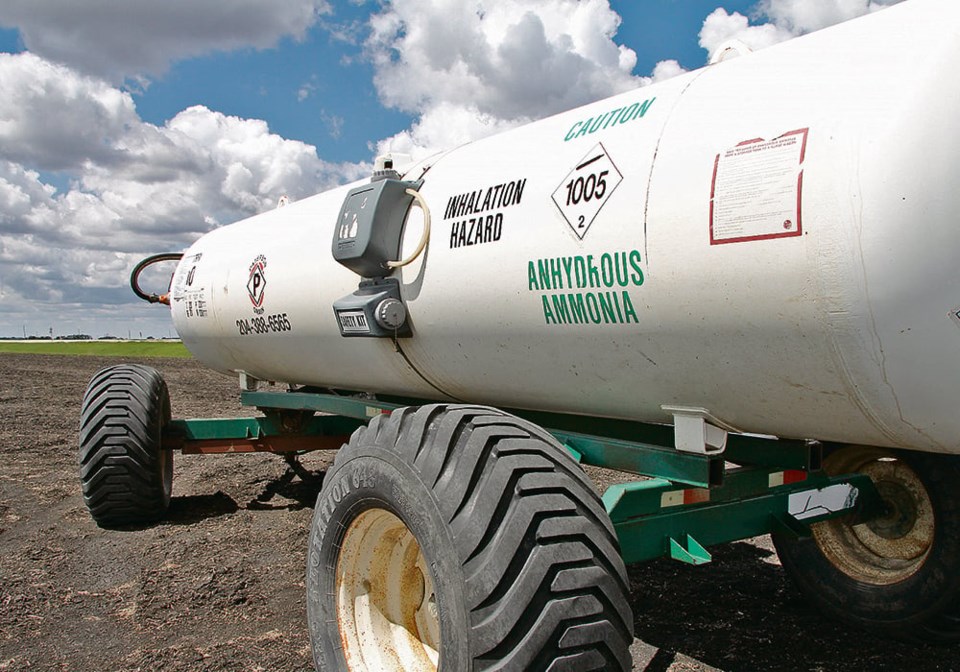WESTERN PRODUCER — Brian Downie, who handles the regulatory side of Shur-Gro’s anhydrous ammonia operations, says he would feel comfortable standing next to any nurse tank currently in service in Canada.
The ag industry weeded out some problem tanks when more robust testing was implemented about a decade ago, he said, but today, he’s confident in the required testing regimen.
“They’re tested so stringently that they’re really, really safe now,” he said.
In February, U.S. officials put out an advisory warning that a certain age and make of nurse tanks were at risk of catastrophic failure.
The advisory stemmed from an August 2023 incident at a farm co-op, in which a tank manufactured by American Welding and Tank (AWT) in 2009 failed and the release of stored anhydrous ammonia caused it to “rocket” 300 metres.
“While no injuries were reported, this event is an indicator of potential continuing problems with AWT nurse tanks that have now been in service for over a decade,” a release from the U.S. Federal Motor Carrier Safety Administration (FMCSA) said.
The company had been subject to an earlier FMCSA investigation for models manufactured in 2009 and 2010. That investigation resulted in “enforcement action in response to improper manufacturing procedures,” the agency said.
After having one tank shoot across their lot, the tank’s owners pursued testing on their other AWT tanks manufactured from 2008-12. Only one, manufactured in 2012, passed radiographic testing. Seven of the eight “had extreme stress corrosion cracking, porosity and inclusions/voids in the welds where the heads and shells of the nurse tanks were joined,” according to the FMCSA.
The tank owner took those tanks out of service and ordered broader follow-up testing of their fleet. Those tests evaluated 142 AWT tanks manufactured between 2007-12. All 2012 tanks passed, but 100 older tanks did not.
The FMCSA and U.S. Pipeline and the Hazardous Materials Safety Administration is now strongly advising anyone with an AWT nurse tank manufactured between Jan. 1, 2007, and Dec. 31, 2011, to get those tanks tested, the February notice said.
The release was picked up by the Canadian Association of Agri-Retailers March 4. Canadian officials were checking if any applicable tanks were sold in Canada, CAAR said.
ADVERTISEMENT
Fertilizer Canada said it is aware of the safety notice and a recommendation that 2009 and 2010 tanks be tested.
“At this time, Fertilizer Canada is not aware of any of these nurse tanks in the Canadian market,” a spokesperson said in an email.
Fertilizer Canada also said it is working to make retailers aware of the situation and remind them of the regulatory requirements.
Downie also says he’s not aware of any tanks that would be covered under the safety notice on Shur-Gro’s lots. Still, he said, “we’re certainly going to do an in-depth audit and make sure that there isn’t any here.”
In Canada, retailers dealing in anhydrous ammonia have guidelines for inspections and testing under the Transportation of Dangerous Goods Regulations and CSA B620 Standard, Fertilizer Canada noted.
Likewise, “all Canadian ammonia agri-retailers are required to maintain compliance with Fertilizer Canada’s Ammonia Code of Practice, which references the regulatory requirements and adds industry best practices.”
That code includes third-party audits every two years.
“They audit our wagons and they audit our site and all the paraphernalia that goes along with anhydrous,” Downie noted, adding that no one is getting anhydrous shipped to them unless they are certified as in compliance with the Ammonia Code of Practice.
There are also random audits from Transport Canada, he added.
Tanks also undergo a hydro test every three to five years.
“Anhydrous is pumped out of these wagons; we fill the wagons full of water and they are pressure tested up past their rating holding capacity,” Downie said.
“We have to hold that test without leakage for a given amount of time.”
Transport Canada also mandates an annual leakage test.
“Every year we do a visual (inspection) and a leakage test and a hose test on every wagon or tank,” Downie said.
“So, on a yearly basis, they probably get in the neighbourhood of two hours of testing each year.”
The hydro test every three to five years requires about an hour and a half, he added.
For farmers with their own nurse tanks, Fertilizer Canada stressed the need to look over tanks daily during application season, as well as before and after each use.
According to an emailed checklist sent to Glacier FarmMedia, those inspections should include:
- Making sure the hitch bolts are in good condition and tight.
- Inspecting hitch welds for stress cracks.
- Ensuring the drawbar tongue is in good shape and that the hitch pin hole is in good condition.
- Checking for the presence and the condition of the chains.
- Inspecting the hose routing and securement.
- Checking the mounting of pedestal bolts that secured the tank to the wagon.
- Checking springs to ensure there are no broken leaves.
- Inspecting welds holding spindles to the frame for cracking.
- Inspecting nurse wagon tires for wear and ensuring lug nuts are present and tight.
- Inspecting the nurse wagon for stress cracks in the frame.
“Annual nurse tank maintenance should include paint, decal and marking maintenance or replacement, valve inspection or replacement, hose testing, and tank inspection and periodic testing,” Fertilizer Canada also said.

